Clinical psychologist specializing in child neuropsychology Luis Miguel Echavarría explains in this article the neurodevelopmental disorders and their impact on cognitive functions.
In recent years interest in understanding how the brain functions, both in normal and pathological conditions, has increased and has raised the need to work in an integrated way at different levels in order to help people who present a given condition.
Neurodevelopmental disorders are within that focus of interest and hence the need to know what consequences they have and the impact they generate in the different areas of a person’s life, emphasizing above all the cognitive area.
For this it is necessary to understand what neurodevelopment implies, how cognitive functions are organized throughout development and how the latter can be affected when an alteration occurs.
What is neurodevelopment?
The development of the nervous system, also called neurodevelopment, is a complex process that begins in the embryonic stage, continues in the fetal period and proceeds throughout life (Enseñat, Roig & Molina, 2015), being marked by a series of changes and comprising several stages (formation of the neural tube, proliferation, migration, organization and myelination), each of them manifested by a particular aspect which together will allow the consolidation of structures, acquisition of skills in different areas and the organization of the person (Medina et al., 2015).
According to Pérez and Capilla (2011), this development is governed by principles:
Discontinuity: indicates that there are changes at different stages that will be qualitatively perceived differently in people, although this can be influenced by the context.
Gene-environment interaction: indicates that human beings have a significant genetic load that shapes our activity, although the environment in which the person develops plays an important role either favorably or adversely, moving away from the conception that we present a biological determinism or environmental determinism.
Hierarchy: the brain is a complex machinery that is organized orderly at different times, with sensory and motor areas forming first and then associative areas. The great complexity of our brain depends to some extent on the connectivity established by its cells (Arnedo, Montes, Bembibre & Triviño, 2015)
It should be noted that the proper development of the nervous system will be externally reflected in the person through motor, emotional, cognitive and other characteristics; however, on this occasion we will focus our attention on the cognitive aspects.
But, what are the cognitive functions?
Cognitive functions, also called neuropsychological functions or higher functions, are a set of mental processes that human beings possess to carry out various activities, thus becoming autonomous and independent.
Ardila and Ostrosky (2012) consider neuropsychological functions to include attention, memory, praxis, gnosia, spatial skills, executive functions, language, reading, writing and calculation.
It should be emphasized that neurodevelopment and cognitive development grow in parallel (Pérez & Capilla, 2011; Artigas-Pallarés & Narbona, 2011) and this growth is different in each person, since as indicated above, there are multiple factors that can influence them.
Knowing the “normal” evolutionary course of cognitive functions is important, because from this it is possible to identify possible alterations and/or deviations from that course (Enseñat et al., 2015).
Relationship between developmental stages, brain development and the acquisition of cognitive abilities
Table 1 presents a brief synthesis of the relationship between developmental stages, brain development and the acquisition of cognitive abilities, all within what we will call the “expected” or “typical development”, better known as “normal” by most people.
Although this is not conclusive, since on the one hand research on the brain is continuous, with new findings, and on the other hand development occurs at different times; however, it allows an approximation and an appreciation of how tangled and indivisible this process is and of how diverse it can be in each person.
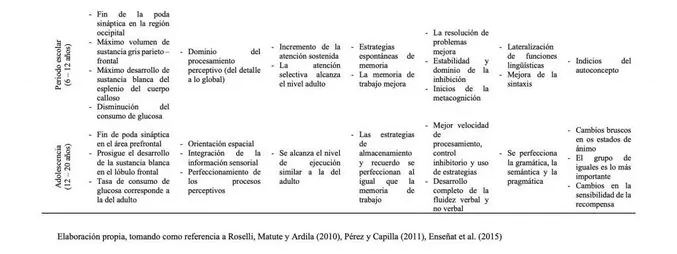
Neurodevelopmental disorders
What is described in Table 1 gives us a reference of the typical; but what happens if some children do not follow those parameters? Then we would be facing a scenario in which there could be a delay in the acquisition of skills or a disorder.
Neurodevelopmental disorders are a group of heterogeneous conditions linked to brain maturation and that follow a stable developmental course (Artigas-Pallarés & Narbona, 2011), characterized by a delay or alteration in the acquisition of skills in domains of development such as motor, social, language and cognition” (Thapar, Cooper & Rutter, 2016), associated with behavioral, social, academic and adaptive functioning difficulties (Artigas-Pallarés, Guitart & Gabau-Villa, 2013).
Classification of neurodevelopmental disorders
There is a wide classification of neurodevelopmental disorders, although according to Artigas-Pallarés and Narbona (2011), they can be divided into:
Those in which there is no specific cause, but which have a genetic basis; here can be placed all those disorders that are listed in the Diagnostic and Statistical Manual of Mental Disorders, fifth edition (DSM – V; American Psychiatric Association [APA], 2014) under the denomination “neurodevelopmental disorders” and are: Intellectual disability, Communication disorders, Autism spectrum disorder (ASD), Attention deficit hyperactivity disorder (ADHD), Specific learning disorders, Motor disorders and Tic disorders.
Alterations in which there is a specific gene and that are linked to structural alterations, such as Down syndrome, Rett syndrome, Williams syndrome, among others.
Those that have a known environmental cause, such as fetal alcohol syndrome, embryonic alterations due to valproic acid, etc.
Technological advances have shed light on how the brain works (D´Souza & Karmiloff-Smith, 2017), although this has not allowed the establishment of brain alterations associated with a specific stage of neurodevelopment.
But what some neuroimaging techniques have allowed is the identification of changes associated with brain and cognitive development (Enseñat et al., 2015).

Subscribe
to our
Newsletter
Impact of Neurodevelopmental Disorders on cognitive functions
Neurodevelopmental disorders generate a great impact on multiple areas and above all on cognitive functions, which limit the individual in their daily life and which differ in each person who presents such an alteration; moreover, it is possible for a person to manifest more than one NDD (Gonzáles, Palazón & Javaloyes, 2020).
Therefore, it is necessary to observe the child’s development and any sign that indicates that they are not on the path of the typical should draw our attention so that they can receive timely care.
These signs, considered “alarm” signs, do not necessarily imply a disorder, but would allow early identification of the presence of some alteration (Medina et al., 2015) and referral to the professional who is most appropriate.
The neuropsychological assessment
To identify these cognitive deficits it is necessary to carry out a neuropsychological assessment that will make it possible to know the child’s performance profile (strengths and weaknesses) by integrating the data into a comprehensive framework that includes several phases and not only focusing on test administration (Echavarría-Ramírez & Tirapu-Ustarroz, in press).
One of the limitations we encounter when we have a case of a suspected neurodevelopmental disorder (NDD) is that the diagnosis is based solely and exclusively on instruments (tests). This is due to, to some extent, the lack of preparation on the part of the professional and the large number of instruments that appear under that denomination and that are the product of commercialization (Benedet, 2017).
This is not intended to discredit tests; on the contrary they are an essential element in evaluation and we know that psychometrics and instrumentation are the pillars of assessment and psychology; however, those who use these tools often lack depth in what they imply and focus their assessment on the score without taking into account other aspects such as the patient’s history, the Press Conference and observation, the diagnosis being in reality a deductive process from these data and which also depends on the theoretical knowledge, specialization and clinical experience of the professional.
Cognitive alterations in neurodevelopmental disorders
Below a table will be presented in which the cognitive alterations in some neurodevelopmental disorders are described and as can be seen, they show a high variability of alterations and cognitive deficits and in many cases it is possible to find comorbidities or overlap with other disorders (Thapar et al. 2016), so care and intervention must be specialized and directed to the needs of each case.
Accordingly, the need for interdisciplinary work can be specified, noting that the intervention for NDDs will largely depend on the type of disorder and the symptoms that predominate in each case (Gonzáles et al., 2020), establishing individualized, differentiated and personalized programs (Echavarría-Ramírez, Díaz-Reyes & Narzisi, 2020; Echavarría-Ramírez & Tirapu-Ustarroz, in press).

Subscribe
to our
Newsletter
Types of intervention
It should be emphasized that types of intervention are divided into pharmacological and non-pharmacological.
1. Pharmacological
Exclusive use of medications; in the case of ADHD methylphenidate is used or in ASD risperidone is used, for example.
2. Non-pharmacological
Psychological interventions aimed at modifying behavior, communication, social skills, family, psychoeducational, among others. Non-pharmacological therapies currently have a greater number of options (Gonzáles et al., 2020), and moreover, they are important and are neither exclusive nor mutually exclusive, but can be combined (Echavarría-Ramírez et al., 2020).
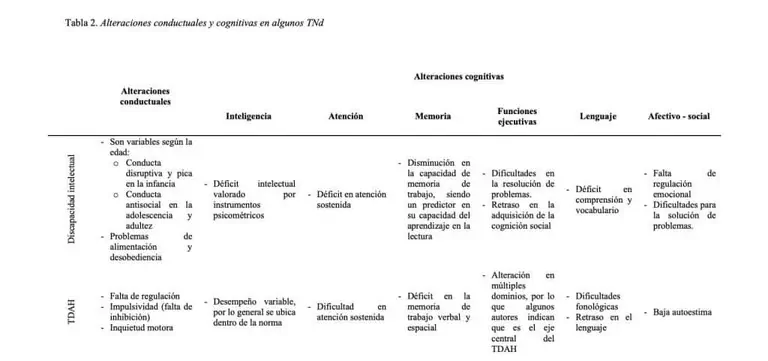
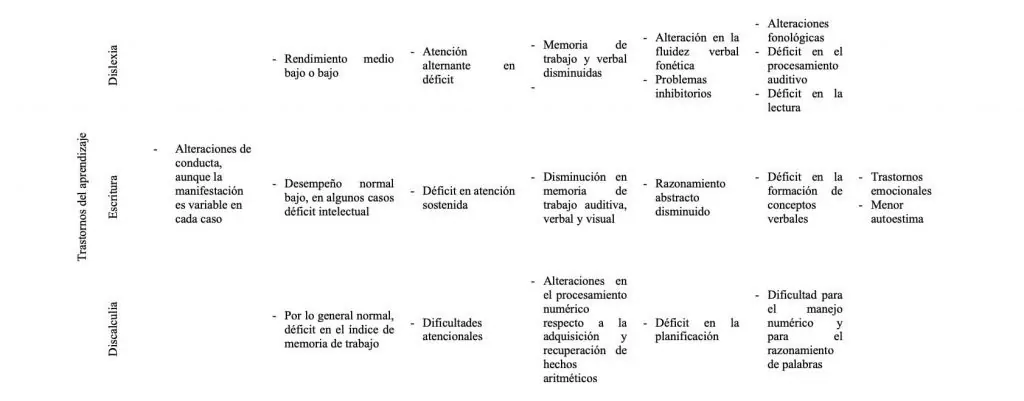
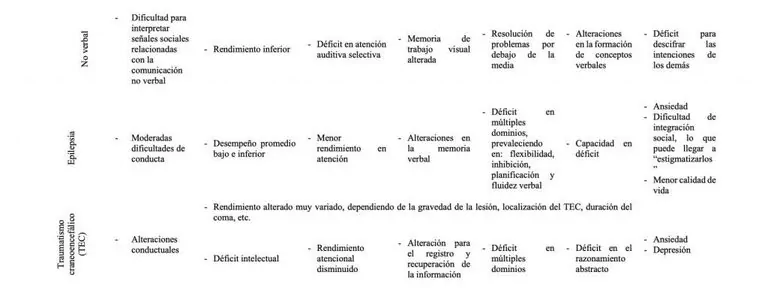
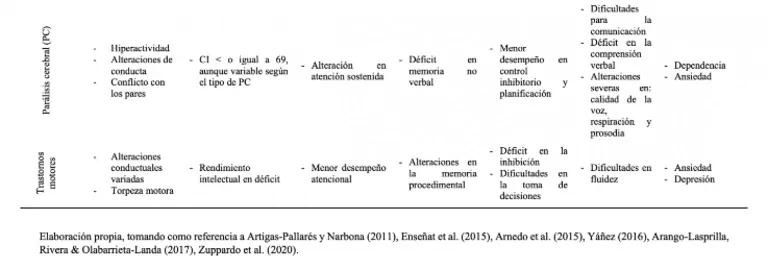
Conclusions
It should be noted that neurodevelopment is a complex process influenced by multiple factors, characterized by various stages, which will ensure the organization of the individual.
An alteration in some of those stages can lead to what is called a neurodevelopmental disorder, which also manifests in diverse behavioral, motor, cognitive, emotional, social ways and in each case such alterations are expressed differently and in some situations overlaps with other disorders are observed and, consequently, the manifestations of the alterations will also be different.
The diagnosis is a process that depends on several factors and is not limited to the exclusive use of tests; although they are necessary, we must take those other variables into account; therefore, from neuropsychology, the need to identify cognitive alterations is fundamental through the “neuropsychological assessment” aimed at analyzing globally the profile of strengths and weaknesses.
Based on the diagnosis, it is essential to implement intervention programs tailored to the needs of each person, without neglecting interdisciplinary work, in order to enhance the child’s development.
Bibliography
- Arango-Lasprilla, J., Rivera, D. & Olabarrieta-Landa, L. (2017). Child Neuropsychology. Bogotá: Manual Moderno.
- Ardila, A. & Ostrosky, F. (2012). Guide to Neuropsychological Diagnosis. México. Ed. Manual Moderno.
- Arnedo, M., Montes, A., Bembibre, J. & Triviño, M. (2015). Child Neuropsychology through Clinical Cases. Madrid: Editorial Médica Panamericana
- Artigas-Pallarés, J. & Narbona, J. (2011). Neurodevelopmental disorders. Madrid: Viguera.
- Artigas-Pallarés, J., Guitart, M. & Gabau-Vila, E. (2013). Genetic bases of neurodevelopmental disorders. Revista de Neurología 56(S01), S23-S34. doi: https://doi.org/10.33588/rn.56S01.2012658
- Asociación Americana de Psiquiatría (2014). Diagnostic and Statistical Manual of Mental Disorders (5° ed.; DSM-5). Arlington, VA.
- Benedet, M. (2017). ADHD is not a negative condition. The cause of such a high percentage of misdiagnoses. An approach from cognitive neuroscience. Madrid: CEPE
- D´Souza, H. & Karmiloff-Smith, A. (2016). Neurodevelopmental disorders. Wiley Interdisciplinary Reviews: Cognitive Science, 8(1-2), e1398–. doi:10.1002/wcs.1398
- Echavarría-Ramírez, L., Díaz-Reyes, D. & Narzisi, A. (2020). Autism Spectrum Disorder: Guideline for management during the period of social isolation due to Coronavirus (COVID-19). Cuadernos de Neuropsicología / Panamerican Journal of Neuropsychology 14(1), 35-41. doi: 10.7714/CNPS/14.1.205
- Echavarría-Ramírez, L. & Tirapu-Ustarroz, J. (in press). Neuropsychological assessment in intellectual disability. Revista de Neurología
If you liked this post about neurodevelopmental disorders and their impact on cognitive functions you may also be interested in these NeuronUP articles:
“This article has been translated. Link to the original article in Spanish:”
Trastornos del neurodesarrollo y su impacto en las funciones cognitivas






 The immense challenge of living a life with autism
The immense challenge of living a life with autism
Leave a Reply